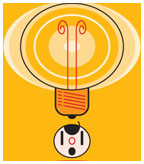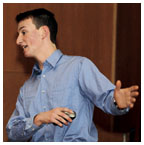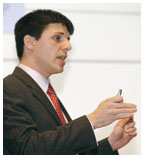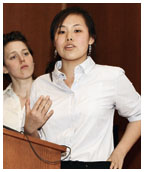
|
March 19, 2008: Features
(Illustrations by J.D.King) |
The
young and the restless
For these youthful alumni, the startups can’t wait
By Brett Tomlinson
 The face
value on tickets for Super Bowl XLII in February ranged from $700 to $900,
and in resale markets, the average cost jumped to about five times the
initial price tag. But what were the tickets really worth? Is there any
way to know?
The face
value on tickets for Super Bowl XLII in February ranged from $700 to $900,
and in resale markets, the average cost jumped to about five times the
initial price tag. But what were the tickets really worth? Is there any
way to know?
Gerry Wilson ’00 and Hagos Mehreteab ’99 have a way to find out. In 2004, the former high school classmates from Piscataway, N.J., sketched out a plan to sell futures contracts for tickets to major sporting events, creating a company called Yoonew (as in, “You knew the Giants were going to the Super Bowl”). Last year, they launched the first market for ticket futures, to allow fans, traders, and ticket brokers to buy and sell contracts throughout the season.
In their system, each contract is worth one championship ticket, provided the designated team reaches the big game, and the contract price rises and falls as traders evaluate the team’s prospects. For example, New York Giants futures bottomed out in mid-December, when a loss to Washington threatened to keep the team out of the playoffs, but the price soared in January as New York won three straight postseason games. With users buying and selling in real time, the final prices of contracts for Super Bowl-bound teams should provide an estimate of what fans think the tickets are worth. This year, the value was between $2,500 and $4,900, depending on the seat location.
“We want people to trade tickets and ticket futures like they trade bonds and stocks,” Mehreteab says. “We use technology to give true price discovery in an industry where price discovery is the whole point of the game.”
Yoonew’s office in midtown Manhattan seems an unlikely hub for a new stock exchange. About a dozen 20-somethings, dressed in jeans and sweatshirts, tap and click away at computers in two connected bullpens. A leather couch sits against one wall, facing a pair of flat-screen TVs, and in the corner, a dorm-room refrigerator stocks the necessities — cans of Red Bull, regular and diet. But on the Web, in the space that matters, Yoonew.com looks as professional as any online brokerage, with price graphs, stadium seating maps, and a scrolling ticker that shows the up-to-date prices of futures contracts for teams vying to play in the NCAA Final Four.
Ticket futures are catching on, according to Wilson, and investors have given Yoonew a solid foundation. As in any startup, there are risks, from technical glitches and market fluctuations to the entry of new competitors, but the founders are unfazed. “Do I feel like I’m being risky?” Mehreteab says. “Not really, in the traditional sense. As an entrepreneur, I feel like I’m the master of my destiny. And I don’t think you could say that about any other type of business.”
Self-reliance is just one of the factors that drive Princeton alumni like Mehreteab and Wilson to strike out on their own and try to turn innovative ideas into profitable companies. Daily challenges, a steep learning curve, and a chance to make a difference in the world contribute as well, according to a handful of Princeton’s young entrepreneurs — mostly engineers — who spoke with PAW.
 In
the high-tech world of medical devices, Chris Loose ’02 has found
a job that he says “could never get boring.” Loose developed
a method of making new antibiotics while pursuing his Ph.D. in chemical
engineering at MIT, working with a small team that initially included
colleague Joel Moxley ’02. Backed by a successful run in business-plan
competitions and support from venture capitalists, Loose’s company,
SteriCoat, is applying the technology to ward off bacterial infections
on medical devices like catheters.
In
the high-tech world of medical devices, Chris Loose ’02 has found
a job that he says “could never get boring.” Loose developed
a method of making new antibiotics while pursuing his Ph.D. in chemical
engineering at MIT, working with a small team that initially included
colleague Joel Moxley ’02. Backed by a successful run in business-plan
competitions and support from venture capitalists, Loose’s company,
SteriCoat, is applying the technology to ward off bacterial infections
on medical devices like catheters.
Robert Moore ’06, a self-described “serial entrepreneur,” relishes any opportunity to combine his creativity and his technological skills. As an undergraduate, he created a hand-held Texas Hold ’Em odds calculator at the height of the online poker craze. His latest venture is a loyalty program that enables online shoppers to help their favorite nonprofits raise money by ordering from participating retailers.
Darren Hammell ’01 says that running a startup, or even just working for one, is filled with “intangible benefits” like understanding exactly how you’ve contributed to the final product. Hammell and co-founders Mark Holveck ’01, Erik Limpaecher ’01, and John Lerch ’01 launched Princeton Power Systems more than six years ago, aiming to develop a low-cost way of making “clean” power, with minimal fluctuations in current. Today, the company’s power converters produce energy that is both clean and green, operating in wind turbines and solar arrays.
While most of these alumni entrepreneurs developed their ideas outside campus labs, their experiences at Princeton helped to shape their interests. Loose, for example, worked on peptide design with chemical engineering professor Chris Floudas, building a strong scientific foundation as he learned about finance and markets by pursuing a certificate in operations research and financial engineering. But his entrepreneurial drive surfaced after college, when he was working as a researcher at Merck. The environment, he says, was not dynamic enough for his taste, so he enrolled in graduate school at MIT, joining a lab known for developing innovative technologies.
After spending four years working with antibiotics and publishing a paper in Nature, Loose began devoting more attention to applications, and he realized that he could improve on the antibiotics currently used to coat medical devices. Loose has developed a long-
lasting, nonleaching antimicrobial coating that, in theory, could be used on everything from needles to artificial joints. “If you want to think of an analogy, it’s like we’ve created a bed of nails on the surface [of a medical device],” he says. “Bacteria run into it, they explode. Human cells run into it and they’re unharmed.”
With a small team of collaborators, Loose first pitched the idea at a business-plan contest, a sort of warm-up for startups. Win or lose, he figured it would be helpful to interact with venture capitalists and experts in science and medicine. At MIT, known as a hotbed for new technologies, the annual 100K Entrepreneurship Competition starts with more than 100 teams and whittles down to a handful of finalists. The rule of thumb is that you want to come in second or third place, Loose jokes, since runner-up teams traditionally have fared well in the real world. SteriCoat exceeded his expectations, capturing the $30,000 top prize in the venture category. The group went on to collect more prize money in contests at Harvard, Columbia, Oxford, and Cambridge.
SteriCoat’s well-practiced pitch soon drew attention from venture capitalists, including two Princeton alumni at 5AM Ventures, a firm that supports early-stage life-science companies. Kevin Forrest *05, a molecular biology Ph.D. who works in the firm’s Boston office, says that SteriCoat met all the requirements of a promising startup: strong intellectual property, based on rigorous science; an application that could fill an unmet need; and a solid, forward-thinking management team. In August 2007, 5AM Ventures agreed to back SteriCoat. Since then, Loose, who completed his Ph.D. last year, has been the company’s chief technology officer, working to develop its first real-world application: an antibiotic catheter that he hopes will reach hospitals by 2011.
John Diekman ’65, a managing partner at 5AM Ventures, says that Loose’s refreshing mix of intelligence, confidence, and a willingness to listen to advice helped seal the deal. “He has the brains and the creativity to be an extraordinary academic if he wanted to,” Diekman says, “but he also realizes that he has an entrepreneurial instinct.”
 The
same entrepreneurial instinct was part of Robert Moore’s makeup
even before he came to college. He had started a Web design company in
high school, building sites for the businesses that his friends’
parents owned. But his first big success as an entrepreneur was born in
the summer after his sophomore year at Princeton.
The
same entrepreneurial instinct was part of Robert Moore’s makeup
even before he came to college. He had started a Web design company in
high school, building sites for the businesses that his friends’
parents owned. But his first big success as an entrepreneur was born in
the summer after his sophomore year at Princeton.
Like many other college students, Moore got caught up in the online poker craze, playing in Texas Hold ’Em tournaments in his free time. But he wasn’t content just to play the cards he was dealt and hope for the best. Moore wanted an edge, so he created a software application to calculate his odds of winning each hand, based on the cards he had and the community cards at the center of the table. He eventually started selling the software online, and it caught the eye of a developer from The Sharper Image, who asked Moore to help him create a hand-held version. Translating his program proved challenging, given the limited computing power available in an inexpensive hand-held gadget. But Moore and his new collaborators got the device on Sharper Image shelves in time for the holiday season, providing what he calls “a nice income boost, for a college student.”
Moore’s knack for gadgets also helped in the classroom at Princeton when he took an entrepreneurial engineering course co-taught by A.J. Khubani, founder of TeleBrands (and “king of the infomercial,” according to ABC’s Nightline). The class project was to engineer a product within a challenging set of parameters: It had to be light, compact, and inexpensive, with a minimum of moving parts. Moore’s team developed a wet-vacuum attachment that earned a marketing deal with TeleBrands, which sells portable staircases for puppies and collapsible, pocket-sized fishing rods, among other things. But as-seen-on-TV success proved elusive: An infomercial for the “Wetter-Vac” never aired, after flopping in the testing phase.
After Moore’s experience with TeleBrands, which included a trip to China for an inside look at the development process, he became interested in the venture-capital side of entrepreneurship, which is now his day job. But he has continued to develop ideas of his own. Spurred by one of his former high school teachers, Moore created SmartRaise, an online fundraising tool that he says is “basically a giant loyalty program.” A nonprofit, like the local PTA, can ask its members to enroll for free, and each time they shop online at a participating retailer, the retailer donates a small portion to the nonprofit. Retailers draw more customers, nonprofits raise money without much effort, and SmartRaise gets a tiny transaction fee. SmartRaise is a volume business, Moore says, and there are no guarantees that the concept will catch on. But regardless, he is confident that this is not his last startup. “I have no doubt in my mind that there will be a next thing,” he says.
 Like
Moore, Hammell and his co-founders at Princeton Power Systems got a boost
in their work from a course at Princeton. In their case, it was “High-Tech
Entrepreneurship,” a perennially popular offering in electrical
engineering taught by Ed Zschau ’61, a technology pioneer, former
IBM executive, and onetime congressman. Hammell’s friends, Limpaecher
and Lerch, built a business plan around a patented technology for power
conversion created by Limpaecher’s father. The basic idea was to
provide a more efficient way to produce “cleaner” power, evening
out fluctuating current with novel circuit designs.
Like
Moore, Hammell and his co-founders at Princeton Power Systems got a boost
in their work from a course at Princeton. In their case, it was “High-Tech
Entrepreneurship,” a perennially popular offering in electrical
engineering taught by Ed Zschau ’61, a technology pioneer, former
IBM executive, and onetime congressman. Hammell’s friends, Limpaecher
and Lerch, built a business plan around a patented technology for power
conversion created by Limpaecher’s father. The basic idea was to
provide a more efficient way to produce “cleaner” power, evening
out fluctuating current with novel circuit designs.
Limpaecher, who now serves as Princeton Power’s lead controls engineer, recruited Hammell and Holveck to expand the idea for Princeton’s student business-plan competition. When their plan won the top prize in 2001, the four classmates decided to stay on campus for the summer after graduation and see if they could turn it into a real company.
That was where Hammell expected it to end. He had a job lined up at Microsoft — his dream job, he thought at the time — and starting a com-pany with three other 22-year-olds seemed like an uncertain career path, at best. But Hammell’s plan changed shortly after graduation when Greg Olsen, a local technology entrepreneur, agreed to pour more than a half-million dollars into their startup.
In the months that followed, the original business plan changed significantly. Instead of serving utility companies, Princeton Power turned its primary focus toward alternative energy. To export wind and solar power to a public utility grid, alternative-energy producers have to meet strict standards for clean power. Princeton Power provides the technology to make that possible, and the market for its products is growing.
Princeton Power’s devices don’t look all that impressive — most consist of a large metal casing, a little smaller than a refrigerator, with an intricate collection of circuits and connected wires at the center — and the company’s quarters at Princeton’s Forrestal Center are spacious but frugally decorated (“no Persian rugs,” Hammell says with a smile). But in two key measures, Princeton Power is a success: The company has grown steadily, thanks in large part to grants from the Department of Energy and contracts with the U.S. Navy and NASA; and in each year since 2005, it has turned a profit.
The path to profitability had its rough spots, Hammell admits, including two months in which the company could not cover its payroll, but the last three years have provided a sense of stability. Princeton Power now employs 17 people — 12 full-time and five part-time — including three of the founders (Lerch left a year after graduation), and the long, draining hours of the group’s first summer — building a technology startup from a dorm room without air-conditioning — seem like a distant memory. “We work a lot less but accomplish more,” Hammell says.
Long hours are still part of the job for Wilson, the CEO of Yoonew, partly because the company’s online market for ticket futures is open 22 hours a day (it used to be 20, but West Coast traders complained that they needed more time). Wilson may sleep a little later than most of his friends, arriving at the office around 10 a.m., but he makes up for it by staying until midnight a few days each week and working weekends. Even when he’s not at work, Yoonew is on his mind. “As much as I try to focus on other stuff, I can’t,” he says.
Wilson’s story since college has been one of lemons-to-lemonade. His first job, with the business-software com-pany MicroStrategy, consisted of two months of training, one day in the main office, and a severance package — the dot-com bubble had burst and there was no room for the new trainees. So Wilson took what he had learned in those two months and became a consultant for companies that used MicroStrategy software. A few years later, while attending business school at MIT, Wilson tried but failed to get tickets to see a Boston Red Sox playoff game. His disappointment became part of his motivation to start Yoonew. And a couple of years after that, when hyper-inflated ticket prices at the 2005 NCAA Final Four threatened to sink Yoonew, Wilson dipped into his retirement savings, fulfilled every ticket contract the company had, and used the experience to revamp his approach to risk management. Yoonew now makes deals with ticket brokers to buy tickets well in advance of big events, avoiding some of the pregame inflation.
Mehreteab, like Wilson, attended business school at MIT after running his own company, a marketing and promotions group. He thought he was ready to join the corporate world, in either investment banking or consulting, but when he heard Wilson’s ideas for Yoonew, he signed on without hesitation. “I had the bug — the startup bug, the entrepreneurial bug — and I couldn’t shake it,” he says.
Courses at Princeton, Wilson and Mehreteab say, taught them practical things that helped them launch Yoonew, from technical knowledge in computer programming to an understanding of markets. Wilson also credits the University for teaching him to think big — a necessity for a successful entrepreneur. “[Princeton] opened up my eyes,” he says. “There’s so much more that you can do, so many new ideas. ... We’re only really limited by our own imagination.”
The next generation of Princeton entrepreneurs is getting a head start on campus, developing their ideas through student-run initiatives like the Princeton Entrepreneurship Club and its TigerLaunch business plan competition (see sidebar). The Center for Innovation in Engineering Education (CIEE) also provides opportunities for students to explore entrepreneurial paths through internships and courses. Engineering Dean H. Vincent Poor *77 established a visiting professorship in entrepreneurship, currently held by Julian Lange ’65, a professor of entrepreneurship and public policy at Babson College; and Olsen, Princeton Power’s initial financier, was named the University’s first entrepreneur-in-residence last year. He meets with students during monthly office hours.
CIEE hosts occasional entrepreneurial-themed lectures, panel discussions, and networking events for students, faculty, and alumni, designed to increase opportunities for “creative collisions,” according to Bob Monsour, CIEE’s associate director for external affairs. But one of the best resources, Monsour says, is simply the chance to see what’s possible, by meeting entrepreneurs like Loose and Hammell, both of whom spoke to students at CIEE events last semester.
Princeton students, Loose says, have a chance to succeed as entrepreneurs because they tend to be well-rounded, well-spoken, and ambitious. Hammell agrees, but he adds that it can be difficult to convince students that the startup route is as rewarding as some of the other career paths open to Princeton graduates.
“When you’re sitting in those chairs in the classrooms,
it’s hard to imagine how much fun it actually is when you get to
this stage,” Hammell says. “The most important part is to
just try. Once you’ve stepped off that cliff, [you’re forced
to] learn so quickly that your chances of success go up and up. That’s
the advice that I try to give, whenever anybody will listen.” ![]()
Brett Tomlinson is an associate editor at PAW.
From top, Seth Priebatsch ’11 gives a winning presentation about SCVNGR; Christian Thériault ’07 is runner-up with a medical innovation; and Jennifer Howard ’09 and Tiffany Ko ’09 take third place with a Web portal for learning-disabled children. (Photos by Frank Wojciechowski) |
Ready
to launch
Students test ideas in business-plan contest
By Brett Tomlinson
Armed with laptops and laser pointers, about a dozen student entrepreneurs have gathered in a lecture hall at the engineering school’s Friend Center Feb. 23 for TigerLaunch, the University’s student-run business-plan competition. The eight semifinalist teams, selected from 21 candidates last fall, have spent dozens of hours researching their target markets and crunching profitability figures. But at the competition’s first round, most of that information takes a backseat to pithy talking points as each team delivers a four-minute “elevator pitch.”
Seth Priebatsch ’11, a newcomer to the competition, is anxious to talk about his company, SCVNGR, which creates high-tech scavenger hunts, distributing clues and tracking progress through text messages to and from the participants’ mobile phones. But the competition’s four-minute limit makes him nervous. “It’s a really complex idea, to get everything out and get it out clearly in four minutes,” he says.
“I just didn’t feel like I was going to have enough time.”
As Priebatsch explains in his pitch, and in an extended presentation later during the afternoon’s final round, text-message scavenger hunts could tap several markets — tourists searching for something to do in a new city, parents hoping to plan a fun and unique birthday party for teens, and corporate clients looking for a fresh, tech-savvy team-building activity. The judges are impressed, awarding
SCVNGR TigerLaunch’s top prize: $5,000, plus free legal services to enable the company to incorporate.
While SCVNGR is the last team standing, it’s not the only one with an innovative idea. Runner-up Princeton Biomedical, led by engineering graduate student Christian Thériault ’07, presents a new way to add texture to titanium orthopedic rods and screws, to promote faster bone growth. Bethani Massey ’10, Jennifer Howard ’09, and Tiffany Ko ’09 of BrightBox Learning, the third-place team, plan to develop a comprehensive Web portal dedicated to the needs of the nearly 3 million American children who have identified learning disabilities.
Other contestants include a team that hopes to use the virtual-reality platform Second Life to provide property tours to prospective real-estate buyers; an undergraduate who aims to build a more flexible alternative to traditional math and physics textbooks, using digital media; and an engineering Ph.D. candidate who wants to create an online invention marketplace in which users could make small investments in promising, patentable ideas.
Any Princeton student who can find the time to put together a 40-page business plan in the middle of the academic year is impressive, says Eric Kutner ’95, a business development consultant in his second year as a TigerLaunch judge. But winning a business-plan competition requires an additional set of skills. Contestants differentiate themselves by presenting their ideas, responding to questions, and being quick on their feet. “That’s what business is — it’s adaptive,” Kutner says.
Priebatsch learns that lesson in the competition’s morning question-and-answer session. SCVNGR’s initial plan is to create prepackaged scavenger hunts that keep players interested with coupon-like incentives. A clue leads the players to a park; when they reach the park successfully, a text message tells them they’ve earned a free scoop of ice cream at a nearby shop. Building a critical mass of willing sponsors will be a challenge, Priebatsch says, and the judges “latched right onto it.”
But Priebatsch’s marketing experience may have assuaged that concern. In his senior year of high school, he launched a company called PostcardTech, which creates postcard-sized mailers that contain mini-CDs, enabling clients to send complex marketing at cheap postage rates. He continues to manage that business from his dorm room, and with the $5,000 from TigerLaunch, Priebatsch hopes to accelerate SCVNGR’s growth — if he can carve a few more hours out of an already hectic schedule.
When he’s asked what drives his entrepreneurial spirit, the freshman outlines the process of developing an idea, making it profitable, and searching for new markets, but then pauses to reconsider. “Honestly,” he says, “it’s just fun.”




